Running Injuries
Why Am I Developing Running Injuries?
Many of us have increased our frequency of running during this pandemic. Running “too much, too soon,” is one of the primary causes of injury. Runners will often experience overuse injuries because of the large amount of miles logged over the course of their training. Poor movement patterns can also contribute to running injuries. As a result, a running assessment assessment is highly recommended by our Doctors of Physical Therapy.
It is crucial to understand and improve your movement patterns to optimize running efficiency. Improper running form may be caused by deficits in strength, flexibility, or coordination. These deficits will place increased strain on the tissues of the body, including muscles, tendons, ligaments, and cartilage.
The body’s tissues will eventually fail over time from the repetitive cyclical stresses from running if the load exceeds their capacity. We will discuss factors that increase the risk of injury, highlight what to keep an eye out for in regards to running form, and finally discuss how these deficits are linked with common running injuries.
Running as a Single-Leg Activity
Running is known to be a single leg sport because the majority of the gait cycle during running is spent propelling yourself forward while using only one leg at a time. As speeds increase, the amount of time spent on one leg increases during the gait cycle. It is necessary to have proper single leg (SL) stability to be able to absorb the impact of landing, and to launch yourself forward into the next step.
There are several planes of motion to consider when assessing your running form. Poor hip stability occurs when we see the hip fail to stabilize as the body attempts to absorb the forces at initial contact. Decreased hip stability will appear as increased hip adduction (frontal plane) or internal rotation (transverse plane) due to strength deficits in the gluteal musculature. Individuals may also display inadequate utilization of the hip in the sagittal plane, which will result in more knee-dominant movement patterns. An increase in this movement knee-dominant pattern places strain on the front of the knee.
One other factor that can change the way your body absorbs the forces of running is decreased core stability. This will place more demand on the hip and knee for stability. These deficits may lead to issues such as knee tendinitis, knee pain, Achilles tendinitis, or meniscus injuries. This is due to decreased shock absorption during the time spent on one leg.
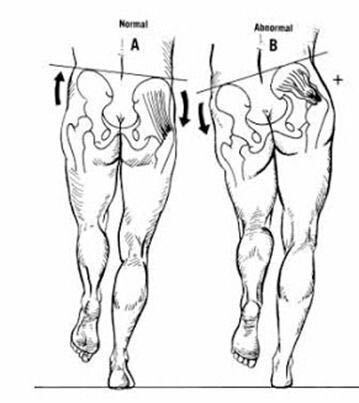
Started From the Bottom
It’s helpful to assess running form while using a systematic approach. We typically start by looking from a “bottoms-up” approach. This allows us to check how the feet are making contact with the ground. Also, it helps us to see how that will affect the rest of the links in the chain as you move up the body. Deviations at the foot, ankle, or lower leg have an immediate effect on the structures further up the kinetic chain. Runners need to pay attention to their foot-contact patterns to see whether they land on the heel or mid/forefoot while they are running. One contact pattern is not necessarily better than the other, but they do present with different advantages and disadvantages.

Heel-strike patterns have higher impact forces, which typically results in increased force through the joints. This pattern will place more stress on the passive tissues (ligaments, cartilage, meniscus, etc.). However, you may want to use a heel-strike pattern to allow for improved hip utilization patterns with decreased strain on the structures lower on the chain, such as Achilles tendon, calf muscle, plantar fascia, patellar tendon, etc.
Mid-/forefoot strike patterns have decreased impact forces and improved shock absorption through the active tissues (muscles, tendons). However, this pattern will place increased strain on the lower leg, such as Achilles tendon, plantar fascia, and posterior tibialis tendon. The benefit of running with this type of stride is to decrease stress on the joints like the knee, hip, and low back.
Running Style
Excessive rotation (supination or pronation) through the foot will result in altered loading patterns in the foot/ankle muscles and cause injuries such as plantar fasciitis, compartment syndrome, posterior tibialis tendinitis, or Achilles tendinitis.
If you are unsure of your preferred running style, take note of the tread on your shoes to see where it is most worn down. Focus on which part of your foot strikes the ground first while you are running and come back to read how each style affects the rest of your stride. If you are considering changing from heel-strike to forefoot-strike pattern, you will need to decrease your mileage until your tissues become accustomed to the new pattern. Many injuries occur when switching styles without decreasing the volume and gradually progressing your mileage.
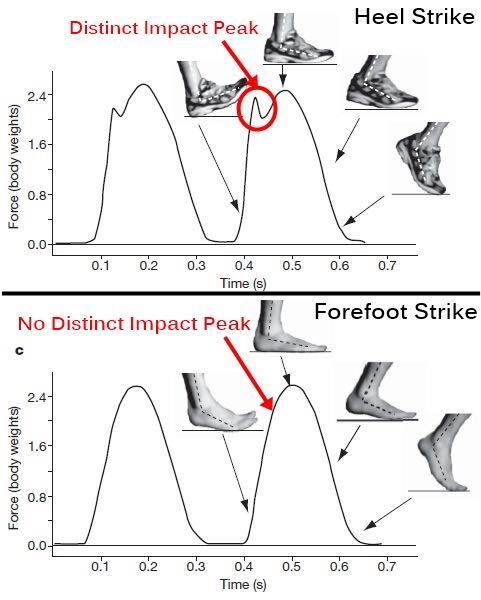
How Does Cadence Affect My Risk for Injury?
Each runner presents with a different strategy to absorb force at impact during the running stride. This is important to understand why an injury may occur. Walking increases ground reaction force by 1.1x bodyweight, while the force of running increases by 2-3x bodyweight. These forces are absorbed by the tissues in the body either actively or passively. Active shock absorption occurs when the joints go through greater ranges of motion to allow for the muscles and tendons to attenuate forces. Passive shock absorption occurs with stiffer landings, causing decreased joint ranges of motion, and increased absorption through ligaments, bones, and cartilage.
Active shock absorption allows for improved efficiency of movement because muscles are able to contract or lengthen like shocks on a bicycle to decrease the stresses on the passive tissues. Passive shock absorption is more tough on the joints because they have a fixed length and can only take a limited amount of force before the tissue fails. We can measure joint angles during a slow-motion running assessment to determine how efficiently you are moving to absorb the forces of running. It’s important to have good flexibility, joint range of motion, and strength to allow for improved absorption of force and decrease the stress on the joints as much as possible. This will allow for improved movement efficiency -> improved performance -> increased mileage -> decreased risk of injury.
Cadence & Shock Absorption
Too much bounce while running or jogging indicates increased impact forces at initial contact. This increases the load that both the active and passive structures have to absorb each step. Step rate or cadence plays a major role in shock absorption. Slower step rates will result in increased vertical bounce while running at your typical pace. Faster cadences at the same pace will decrease vertical displacement and allow for decreased forces to absorb at impact.
Normal cadence for runners is about 180 steps per minute, but according to Heiderscheit et al, “an increase in step rate (cadence) to 10% more than your typical self-selected pace will help to decrease vertical displacement, causing decreased: forces at knee and hip joints, compressive stresses to patellofemoral joint, braking impulse, and peak valgus moments (hip adduction and internal rotation).” (Heiderscheit 2011). Increasing your step rate will make it easier to absorb the forces of running. This will also make it more challenging to your cardiovascular system, but your heart and lungs will adapt to operate more efficiently as you train with increased cadence. For more information on step-rate you can read more here: (Heiderscheit et al 2011; Schubert et al 2014)
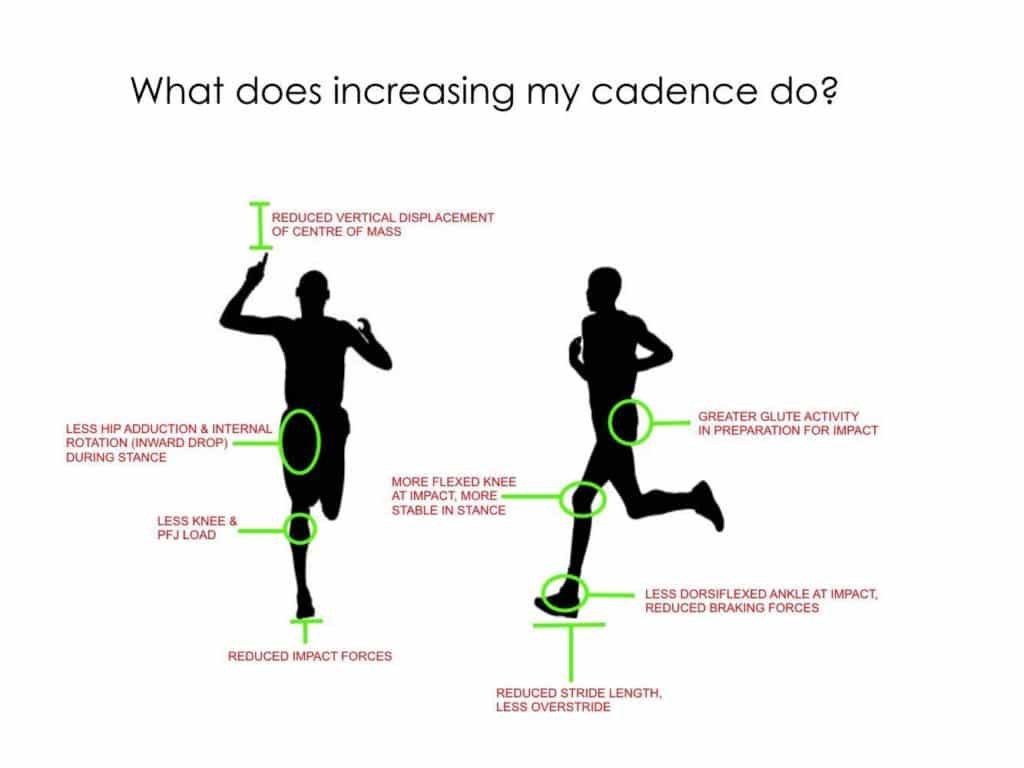
Image courtesy of http://www.smartstride.com.au/cadence-why-more-is-better/
Running Assessment
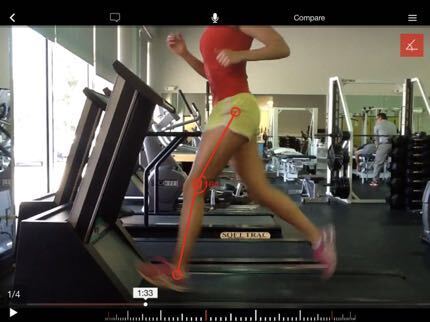
It is important to perform a self-assessment to see how your body responds to each run. Are your calves, hip flexors, or hamstrings tight? Do you have pain in your heel, knee, or low back? Which muscles feel most fatigued? It is important to assess these things because they are often indicators of an area that needs to improve. We typically will test muscle flexibility, joint mobility, strength, and single-leg stability. Then, we look for compensatory patterns, preferred step-rate, and typical foot-strike patterns during the movement assessment. Below we will discuss how some of these deficits may factor into specific injuries.
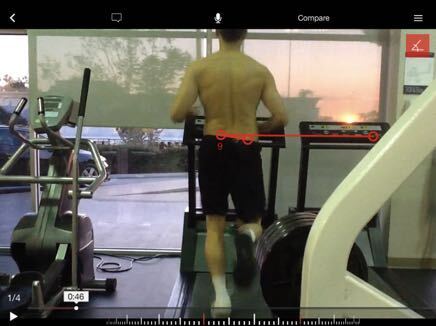
Flexibility deficits in the quadriceps, hamstrings, or calf musculature can lead to altered loading patterns. It can aslo place you at risk for developing low back pain, knee pain, plantar fasciitis, or Achilles tendinitis. Decreased great toe extension or ankle dorsiflexion range of motion can cause increased stress on the plantar fascia. In addition, it can cause stress to the Achilles tendon. and knee due to poor shock absorption. Hip flexor tightness can cause a decrease in hip extension, which can result in low back pain, poor dynamic core and hip stability, limited gluteal strength, and increased strain on Achilles tendon or calf muscles.
- Poor dynamic hip stability can be identified by excessive hip adduction, internal rotation, or tight hip flexors
- Indicative of weakness of the gluteus maximus muscle.
- Poor pelvic/trunk stability can be identified by a crossover step pattern, pelvic drop, or lateral trunk lean
- Indicative of strength deficits in the gluteus medius musculature.
- Quadriceps-dominant movement patterns are seen when running or squatting with the heels coming off the ground or with excessive upright posture through the trunk
- Places increased stress on the front of the knee
Running-Related Injury Matrix
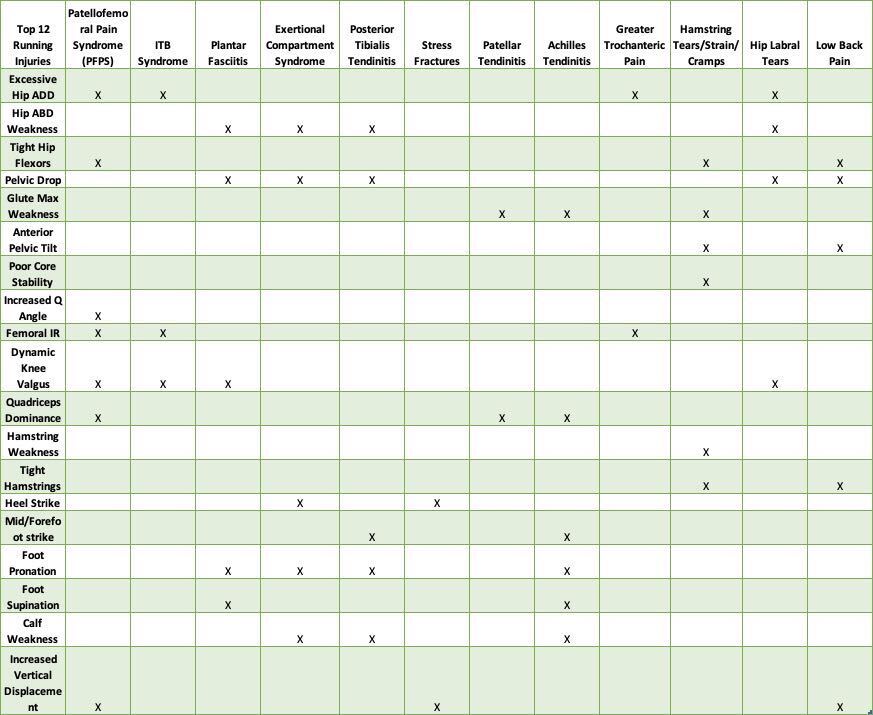
Above is a chart highlighting the top 12 running-related injuries, and which deficits are most commonly associated with each injury. The body is complex and everyone is different. This chart can be a useful way to understand how each of these deficits can add up to cause a certain diagnosis. Runners will benefit from a thorough assessment to identify these areas in need of improvement to prevent injury. It’s best not to wait until an injury occurs. It is easier to manage these deficits prior to injury to avoid a required stop in training. We offer a full evaluation of strength, ROM, flexibility, movement and running assessment to find any deviations that may be placing you at a higher risk for injury.
Interested in learning more about your stride to optimize your movement efficiency? Come in for a running evaluation to improve your performance and decrease your risk of injury! First, we start by measuring your ROM and film your running form in slow motion. Second, we measure the angles of your joints to see how well you are absorbing shock. Lastly, we provide feedback to make adjustments to form to optimize movement efficiency. Good luck in your training and remember to run FAST!
Written By: Dr. Timothy Alemi, PT, DPT, SCS
